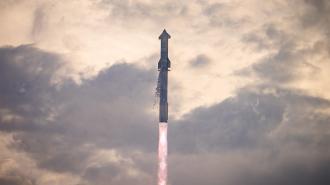This morning, millions of people tuned in to watch the third test flight of SpaceX’s Starship, no doubt eager to see whether this would be the first fully successful flight of the world’s largest rocket — or one more explosive learning experience along the way.
The big event kicked off at 9:25 am ET, and one minute in, everything was looking great — the launchpad survived lift-off, and all 33 of the Raptor engines on its Super Heavy booster had ignited.
At +2:45 minutes, all but three of those engines shut off and the upper stage engines ignited with the booster still attached. This is called “hot staging,” and it also went off without a hitch (just as it had during the second test flight).
The booster then separated about 3 minutes into the flight, freeing Starship’s upper stage to continue its climb into orbit.
Starship’s six Raptor engines then shut down at 8:40 minutes into the flight. It was now coasting through space — and officially further along than the second Starship, which exploded just after crossing the border into space.
Meanwhile, a controlled reentry of the Super Heavy booster went well, until it didn’t — SpaceX lost contact with the booster, leading to a hard splashdown in the Gulf of Mexico. The reason is TBD, according to SpaceX.
SpaceX’s livestream crew then took a break for about 30 minutes, during which SpaceX took advantage of having a Starship in space to conduct several tests, including opening and closing the payload door. Anyone still watching got to enjoy some jazzy lofi with their morning coffee.
Finally, it was time for the next big objective: reentry and splashdown.
Thanks to Starlink terminals attached to Starship, the views were amazing, particularly during the rocket’s descent through Earth’s plasma shield — until SpaceX lost signal with Starship.
By then, more than 3 million people were tuned in to the livestream to see whether SpaceX would regain signal and bring Starship in for a soft landing, but 65 minutes after launch, SpaceX called it: Starship was lost.
Starship may not have stuck the landing during its third test flight, but SpaceX will likely get another chance at it very soon — the company’s goal is to fly at least nine Starships in 2024.
That rapid cadence will likely be necessary if SpaceX hopes to have the rocket ready to return people to the moon as soon as 2026 — and meet CEO Elon Musk’s objective of uncrewed trips to Mars as soon as 2027.
We’d love to hear from you! If you have a comment about this article or if you have a tip for a future Freethink story, please email us at [email protected].






